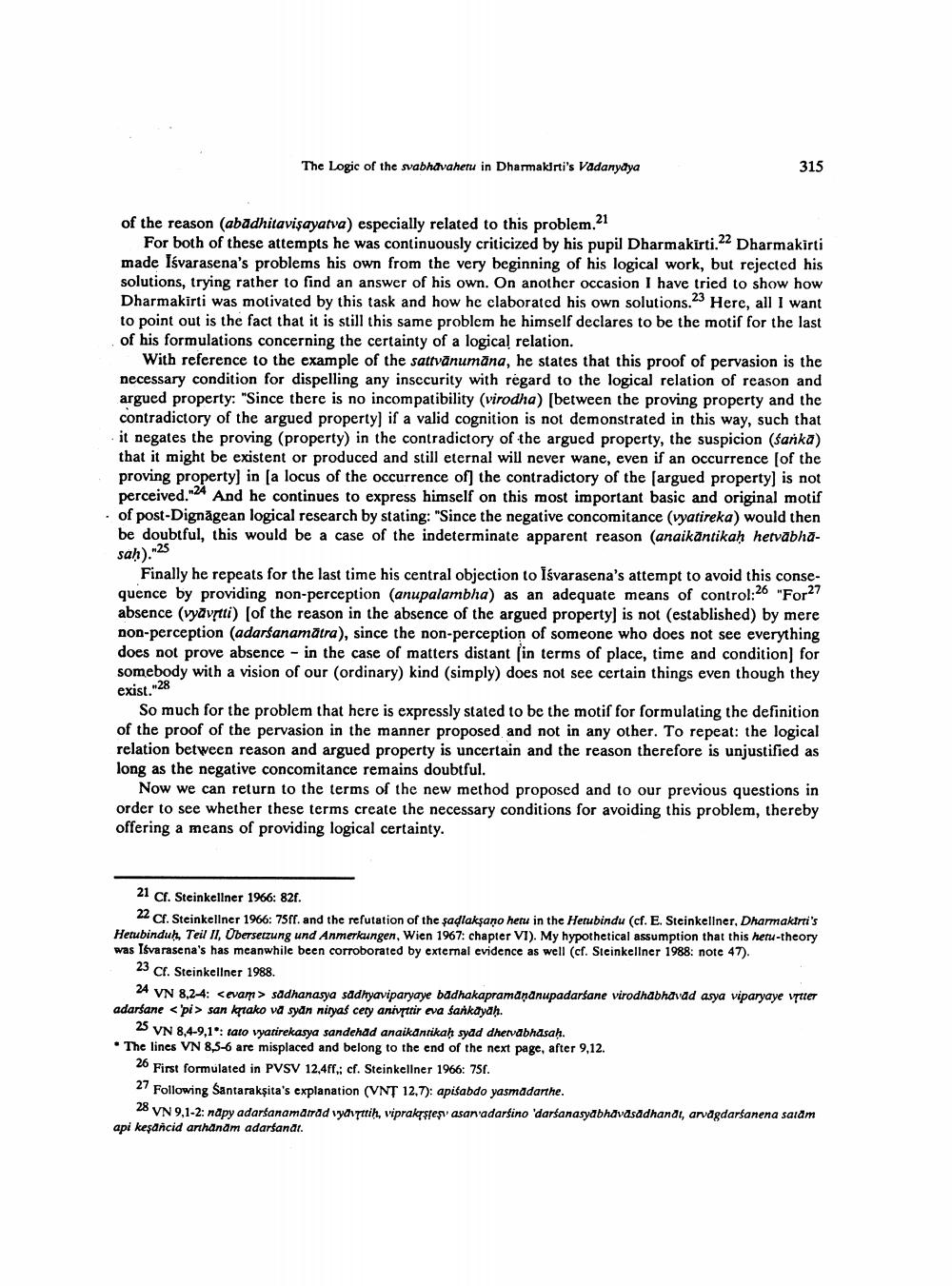Book Title: Logic Of Svabhavahetu In Dhharmakirtis Vadanyaya Author(s): Ernat Steinkellner Publisher: Ernat Steinkellner View full book textPage 5
________________ The Logic of the svabhavahetu in Dharmakirti's Vadanyaya 315 of the reason (abadhitavişayatva) especially related to this problem.21 For both of these attempts he was continuously criticized by his pupil Dharmakirti.22 Dharmakirti made Iśvarasena's problems his own from the very beginning of his logical work, but rejected his solutions, trying rather to find an answer of his own. On another occasion I have tried to show how Dharmakirti was motivated by this task and how he claborated his own solutions.23 Here, all I want to point out is the fact that it is still this same problem he himself declares to be the motif for the last of his formulations concerning the certainty of a logical relation. With reference to the example of the sattvānumāna, he states that this proof of pervasion is the necessary condition for dispelling any insecurity with regard to the logical relation of reason and argued property: "Since there is no incompatibility (virodha) [between the proving property and the contradictory of the argued property] if a valid cognition is not demonstrated in this way, such that it negates the proving (property) in the contradictory of the argued property, the suspicion (śańkā) that it might be existent or produced and still eternal will never wane, even if an occurrence [of the proving property] in [a locus of the occurrence of] the contradictory of the [argued property] is not perceived."24 And he continues to express himself on this most important basic and original motif of post-Dignāgean logical research by stating: "Since the negative concomitance (vyatireka) would then be doubtful, this would be a case of the indeterminate apparent reason (anaikantikaḥ hetvābhāJah).-25 Finally he repeats for the last time his central objection to Isvarasena's attempt to avoid this consequence by providing non-perception (anupalambha) as an adequate means of control:26 "For27 absence (vyavṛtti) [of the reason in the absence of the argued property] is not (established) by mere non-perception (adarśanamatra), since the non-perception of someone who does not see everything does not prove absence in the case of matters distant (in terms of place, time and condition] for somebody with a vision of our (ordinary) kind (simply) does not see certain things even though they exist."28 So much for the problem that here is expressly stated to be the motif for formulating the definition of the proof of the pervasion in the manner proposed and not in any other. To repeat: the logical relation between reason and argued property is uncertain and the reason therefore is unjustified as long as the negative concomitance remains doubtful. Now we can return to the terms of the new method proposed and to our previous questions in order to see whether these terms create the necessary conditions for avoiding this problem, thereby offering a means of providing logical certainty. 21 Cf. Steinkellner 1966: 82f. 22 Cf. Steinkellner 1966: 75ff. and the refutation of the şadlaksano hetu in the Hetubindu (cf. E. Steinkellner, Dharmakirti's Hetubinduḥ, Teil II, Übersetzung und Anmerkungen, Wien 1967: chapter VI). My hypothetical assumption that this hetu-theory was Isvarasena's has meanwhile been corroborated by external evidence as well (cf. Steinkellner 1988: note 47). 23 Cf. Steinkellner 1988. 24 VN 8,2-4: <evam> sadhanasya sadhyaviparyaye badhakapramäṇānupadarśane virodhābhavad asya viparyaye vṛtter adarsane <'pi> san kako va syan nityas cety anivṛttir eva sankayaḥ. 25 VN 8,4-9,1*: tato vyatirekasya sandehad anaikāntikaḥ syād dhetvābhāsaḥ. The lines VN 8,5-6 are misplaced and belong to the end of the next page, after 9,12. 26 First formulated in PVSV 12,4ff,; cf. Steinkellner 1966: 75f. 27 Following Santarakşita's explanation (VNT 12,7): apiśabdo yasmadarthe. 28 VN 9,1-2: napy adarśanamäträd vyavṛttiḥ, viprakrstes asarvadarsino 'darśanasyabhäväsädhanät, arvagdarśanena salām api keşancid arthānām adarśanāt.Page Navigation
1 ... 3 4 5 6 7 8 9 10 11 12 13
